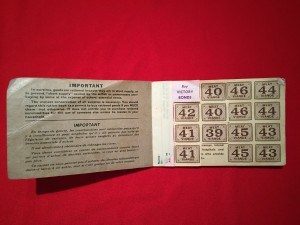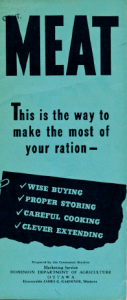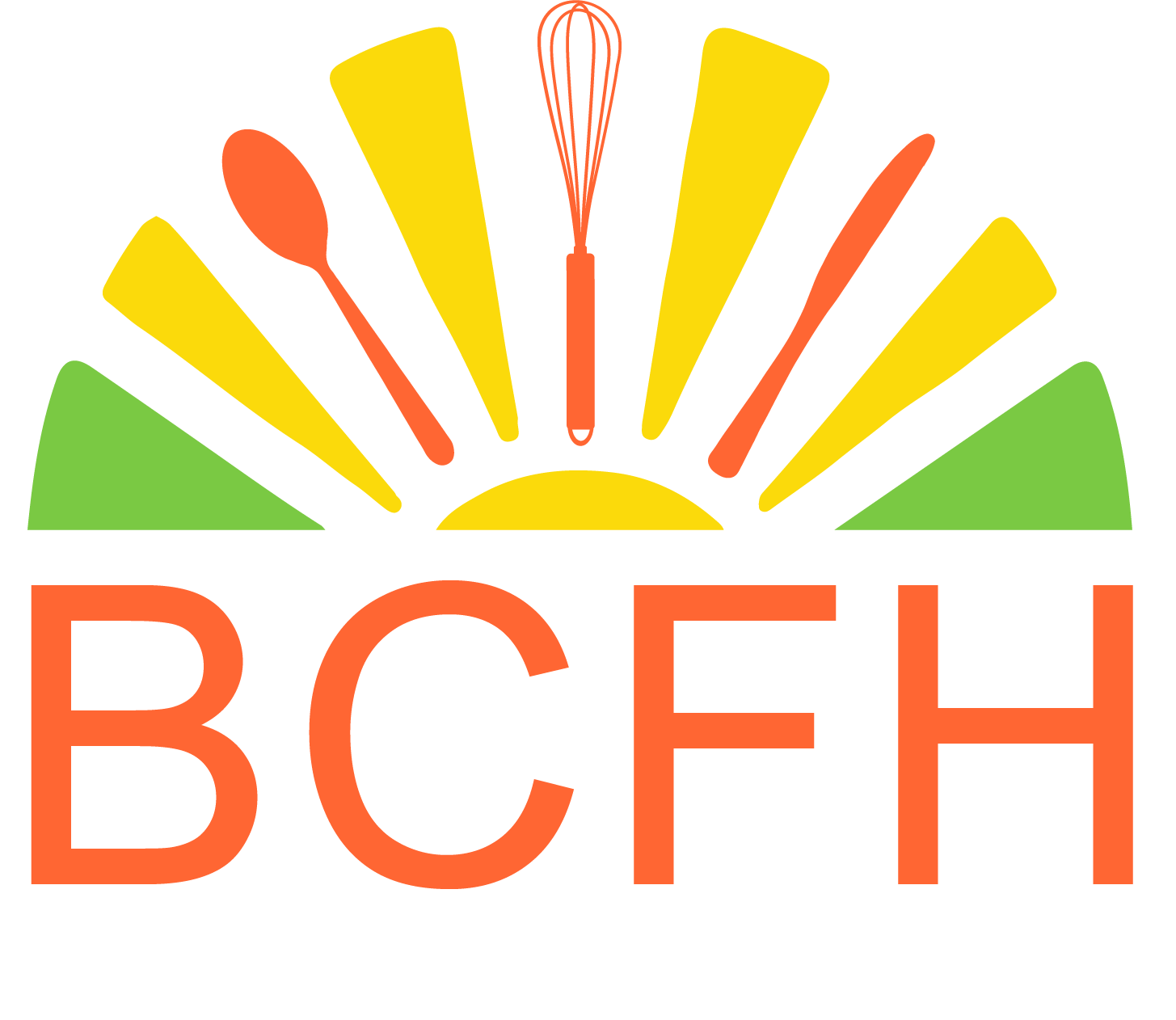I was going through an old button box the other day when I came across this:
Not knowing what it was, I had to do a little research. It turns out that it is a meat ration token from World War II produced by the Canadian Government. People who lived through the war years in the 1940’s will be familiar with these ration tokens. They were used in conjunction with ration books and coupons.

Canadian Ration Book from World War II[i]

Food Rationing Coupons from World War II [ii]
During WWII, food was tightly rationed. Sugar, coffee and tea were strictly limited because they were imported products while other foods such as meat, flour, cheese, eggs were rationed to free up supplies so they could be send overseas to feed the troops. Since there were shortages, rationing was used to ensure that everyone got their fair share of the foods that were in short supply.
The Wartime Prices and Trade Board (TPTB) was formed in September 1939 and issued food ration coupons starting in 1942. Canadian households had to fill out an application form for the ration book and wait for it to be mailed as the coupon books were distributed through the Post Office. All Canadian adults and children were issued the books. The coupons had to be detached in the presence of the grocer or butcher when the purchase was made. A total of 6 different war ration books were issued from 1942 to 1945. Each book contained between 7 and 10 panes of sequentially numbered coupons, and a postcard that needed to be sent in to get the next book. In the end, more than 11 million ration books were distributed. Typical items that were on the ration list included meat, butter, sugar, tea and coffee. Meatless Tuesdays and Fridays were encouraged and endless rationing information was distributed. Mosby (2014) estimates that at least 200 cookbooks were published during the war[iii]. Government publications and posters were also prevalent, for example this 11 page pamphlet produced by the Department of Agriculture.

Dept. of Agriculture Meat Ration Booklet [iv]
To solve the problem of possible waste, during the second round of meat rationing, the Canadian Government issued meat tokens like the one I found in the button box. Eight tokens were the equivalent of one coupon[vi]. If the amount of meat purchased did not take up the whole coupon, the dealer could now give the customer ration ‘change’ in the form of tokens. This time around the meat ration’s size was modified. The former meat ration of two pounds a week which had been very generous would have to be much less if the goal of sending more meat overseas was to be achieved. The aim of the new ration was to reduce the average Canadian’s annual meat consumption from approximately 141 to 131 pounds. Accordingly, the new ration figure was one-and-a-third pounds of meat per person per week[vii].
While rationing did require the average Canadian to eat less butter, sugar, and tea, the approximately two pounds of meat per person per week promised under meat rationing – in combination with access to off-ration meats in restaurants and elsewhere – actually assured a level of consumption from legal sources that was in excess of what most Canadians were eating during the Depression[viii] .Therefore while there were shortages, for most civilians rationing was more of a nuisance than a hardship. Meat rationing was in all probability harder on retailers than on consumers. Dealers, many of whom already lacked workers, now had to reconcile meat purchases with coupon values, an added burden in addition to physically handling and collating the accumulated coupons[ix].
In present times where food is seemingly abundant and available in endless amounts and diversity it is hard to image simpler times and the rationing of food that we take for granted or of the sacrifice of young men and women so that we can live in peace.
[i] Source of Image: https://captainstevens.com/militaria-for-sale-and-wanted/for-sale-misc-militaria/
[ii] Source of image: https://captainstevens.com/militaria-for-sale-and-wanted/for-sale-misc-militaria/
[iii] Mosby, I. (2014). Food will win the war: The politics, culture, and science of food on Canada’s home front. Vancouver, BC: UBC Press.
[iv]Source: http://wartimecanada.ca/archive-categories/rationing
[v] Florence, E. (2016). Wartime rations meant Canadian cooks got creative. https://www.e-know.ca/regions/east-kootenay/wartime-rations-meant-canadian-cooks-got-creative/
[vi] Sam Waller Museum (2014). WWII Meat Ration Token. http://www.samwallermuseum.ca/feature/?id=39
[vii] Barker, S. (2008) Feeding the Hungry Allies:Canadian Food and Agriculture during the Second World War. PHD dissertation, University of Ottawa
[viii] Mosby, I. (n.d.). Food on the Home Front during the Second World War. http://wartimecanada.ca/essay/eating/food-home-front-during-second-world-war
[ix] Barker, S. (2008) Feeding the Hungry Allies:Canadian Food and Agriculture during the Second World War. PHD dissertation, University of Ottawa


Great Article Gale. Very interesting.
I use to look for this kind of info fior lessons when Rememberance day was approaching.
Sharon Relkey